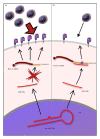HLA-G/C, miRNAs, and their role in HIV infection and replication
- PMID: 23841087
- PMCID: PMC3697138
- DOI: 10.1155/2013/693643
HLA-G/C, miRNAs, and their role in HIV infection and replication
Abstract
In recent years, a number of different mechanisms regulating gene expressions, either in normal or in pathological conditions, have been discovered. This review aims to highlight some of the regulatory pathways involved during the HIV-1 infection and disease progression, focusing on the novel discovered microRNAs (miRNAs) and their relation with immune system's agents. Human leukocyte antigen (HLA) family of proteins plays a key role because it is a crucial modulator of the immune response; here we will examine recent findings, centering especially on HLA-C and -G, novel players lately discovered to engage in modulation of immune system. We hope to provide novel perspectives useful to find out original therapeutic roads against HIV-1 infection and AIDS progression.
Figures




Similar articles
-
Human leukocyte antigen (HLA)-C and its association with HIV-1 transmission in discordant couple and mother-to-child cohorts.Immunogenetics. 2018 Nov;70(10):633-638. doi: 10.1007/s00251-018-1075-1. Epub 2018 Aug 20. Immunogenetics. 2018. PMID: 30128812
-
Association of HLA-C and HCP5 gene regions with the clinical course of HIV-1 infection.AIDS. 2009 Jan 2;23(1):19-28. doi: 10.1097/QAD.0b013e32831db247. AIDS. 2009. PMID: 19050382
-
HLA-C cell surface expression and control of HIV/AIDS correlate with a variant upstream of HLA-C.Nat Genet. 2009 Dec;41(12):1290-4. doi: 10.1038/ng.486. Nat Genet. 2009. PMID: 19935663 Free PMC article.
-
The emerging role of HLA-C in HIV-1 infection.Immunology. 2011 Oct;134(2):116-22. doi: 10.1111/j.1365-2567.2011.03474.x. Immunology. 2011. PMID: 21896007 Free PMC article. Review.
-
The Role of MicroRNAs in HIV Infection.Genes (Basel). 2024 Apr 29;15(5):574. doi: 10.3390/genes15050574. Genes (Basel). 2024. PMID: 38790203 Free PMC article. Review.
Cited by
-
COVID-19: Mechanisms, risk factors, genetics, non-coding RNAs and neurologic impairments.Noncoding RNA Res. 2023 Jun;8(2):240-254. doi: 10.1016/j.ncrna.2023.02.007. Epub 2023 Feb 23. Noncoding RNA Res. 2023. PMID: 36852336 Free PMC article. Review.
-
Inhibition of host immune response in colorectal cancer: human leukocyte antigen-G and beyond.World J Gastroenterol. 2014 Apr 14;20(14):3778-94. doi: 10.3748/wjg.v20.i14.3778. World J Gastroenterol. 2014. PMID: 24744572 Free PMC article. Review.
-
MicroRNA-1297 participates in the repair of intestinal barrier injury in patients with HIV/AIDS via negative regulation of PLCβ1.Mol Cell Biochem. 2022 Aug;477(8):2133-2147. doi: 10.1007/s11010-022-04426-z. Epub 2022 May 24. Mol Cell Biochem. 2022. PMID: 35608718
-
Down-expression of miR-152 lead to impaired anti-tumor effect of NK via upregulation of HLA-G.Tumour Biol. 2016 Mar;37(3):3749-56. doi: 10.1007/s13277-015-3669-7. Epub 2015 Oct 14. Tumour Biol. 2016. PMID: 26468017
-
The double-sided of human leukocyte antigen-G molecules in type 1 autoimmune hepatitis.Front Immunol. 2022 Oct 12;13:1007647. doi: 10.3389/fimmu.2022.1007647. eCollection 2022. Front Immunol. 2022. PMID: 36311782 Free PMC article.
References
-
- Segat L, Catamo E, Fabris A, et al. HLA-G*0105N allele is associated with augmented risk for HIV infection in white female patients. AIDS. 2010;24(12):1961–1964. - PubMed
Publication types
MeSH terms
Substances
LinkOut - more resources
Full Text Sources
Other Literature Sources
Medical
Research Materials

